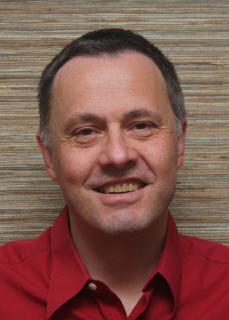Nikolaus Grigorieff
Nikolaus Grigorieff has always enjoyed figuring out how electronic gadgets work, building them, and speaking their language using mathematics, circuitry diagrams, and computer algorithms.
As a boy growing up in Berlin (Germany) in the 70s and 80s, he used a toaster and two pieces of pencil graphite to construct an arc lamp, which used electricity to create a bright light. To tease his mother, who would shut off the electricity in the house when he played his music too loud, Grigorieff built a generator to independently operate his stereo. His mother was very happy. He even programmed an early computer to play the game "Battleship" with him—and lost.
Today, Grigorieff's gadget of choice is a 300,000-Volt electron microscope (EM), which he uses to see molecules that operate as minute biological "machines" inside of cells. Grigorieff writes his own specialized computer software to transform data from the microscope into vivid, three-dimensional images of a cell's components.
Grigorieff came to biology after studying physics. His Ph.D. thesis focused on semiconductor devices and their analysis with the EM at the University of Bristol (UK). But the work was more concerned with engineering than an intellectual quest to explore new territory.
As a postdoctoral fellow at the Medical Research Council in Cambridge (UK), he used the EM to study large biological complexes. At the time, scientists couldn't see the level of detail that they would have liked in these structures. So Grigorieff developed EM techniques and algorithms to make higher-resolution images of protein complexes inside cells to reveal greater detail.
In particular, Grigorieff studied the structure of the first enzyme complex in the electron transport chain in the mitochondrion (complex I). The organelle uses molecules within it to extract energy from sugar.
Grigorieff was able to obtain a 20-Ångström-resolution structure of the complex, improving upon earlier structures of this complex. Resolution distinguishes two points in a structure—the smaller the resolution value, the greater the ability to see more detail. During the past two decades, Grigorieff has improved his method and achieved resolutions of 1.6 Ångströms in some structures.
Once he has taken many pictures of the molecule, Grigorieff uses the computer algorithms he has written to reassemble the structure. This process is analogous to computerized tomography, when radiologists take X-rays of an organ from different points of view and reconstruct a three-dimensional image. However, in Grigorieff's work one does not know beforehand what side of a molecule is observed. Grigorieff devised ways to infer where each image of the molecule belongs in terms of top, bottom, side, and so on. Then, the images can be put together three dimensionally.
Grigorieff, who started his own lab at Brandeis University in 1999, hopes to improve the resolution of complex structures to, perhaps, 1 Ångström. But the task is challenging: Most biological complexes exist in many forms and are flexible. More recently, he has also begun to work on cryo-EM methods to see complexes directly inside images of cells. This will help him understand how these complexes interact with other molecules and complexes in a cell, and how they are regulated.
Dr. Grigorieff became an investigator of the Howard Hughes Medical Institute in 2000, and a member of the National Academy of Sciences (USA) in 2021. You can view his profile on ResearchGate.
Please also read his story on SBGrid Tales.
Dr. Grigorieff likes to spend his free time taking pictures of the sky. Check out some of his pictures here.![]()




